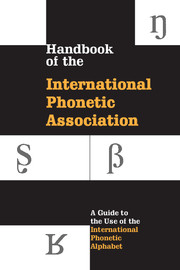 Handbook of the International Phonetic Association
Handbook of the International Phonetic Association Published online by Cambridge University Press: 06 November 2023
The History of the International Phonetic Association
1 The Association
The Association was founded in Paris early in 1886 under the name of Dhi Fonètik Tîcerz’ Asóciécon (the FTA), which was itself a development of L’Association Phonétique des Professeurs d’Anglais. A small group of language-teachers came together, under the leadership of Paul Passy, to press the case for phonetic notation to be used in schools as a method of helping children to acquire a realistic pronunciation of foreign languages. A further use of phonetic notation was seen to be in the teaching of reading to young children. In these aims, particularly the former, the Association was supported by the examples and encouragement of language-teachers and phoneticians in other countries such as Johan Storm in Norway, Henry Sweet and Henry Widgery in Britain, and Hermann Klinghardt and Wilhelm Viëtor in Germany.
In less than a year, the membership had grown from an initial eleven members in France to 58 in twelve countries, mainly in Western Europe. By the summer of 1914, which was the high point of the Association’s existence in terms of membership and influence in education circles, there were 1751 members in 40 countries. In January 1889, the name of the Association was changed to L’Association Phonetique des Professeurs de Langues Vivantes (AP), and, in 1897, to L’Association Phonetique Internationale (API) - in English, the International Phonetic Association (IPA). The Association’s activities were severely disrupted by the First World War and its aftermath. No journal appeared between October 1914 and December 1922, although circumstances did allow the occasional publication of a handful of Supplements on particular aspects of phonetics.
It was the Danish phonetician Otto Jespersen who first suggested, in 1886, that there should be what he called an ‘International Phonetic Association’, which would devise an international alphabet rather than a set of different alphabets specific to particular languages (see 4 below on the development of the Alphabet). Passy himself favoured the compromise of an ‘International Society’ made up of a confederation of national bodies, whose aim would be ‘the advancement of the science of phonetics and its application to practical teaching’. Jespersen’s proposal, however, failed to get the support of a majority of the FTA’s membership, and the Association continued as a forum for language-teachers dedicated to the cause of phonetic script rather than as an organization of academic phoneticians.
To save this book to your Kindle, first ensure [email protected] is added to your Approved Personal Document E-mail List under your Personal Document Settings on the Manage Your Content and Devices page of your Amazon account. Then enter the ‘name’ part of your Kindle email address below. Find out more about saving to your Kindle.
Note you can select to save to either the @free.kindle.com or @kindle.com variations. ‘@free.kindle.com’ emails are free but can only be saved to your device when it is connected to wi-fi. ‘@kindle.com’ emails can be delivered even when you are not connected to wi-fi, but note that service fees apply.
Find out more about the Kindle Personal Document Service.
To save content items to your account, please confirm that you agree to abide by our usage policies. If this is the first time you use this feature, you will be asked to authorise Cambridge Core to connect with your account. Find out more about saving content to Dropbox.
To save content items to your account, please confirm that you agree to abide by our usage policies. If this is the first time you use this feature, you will be asked to authorise Cambridge Core to connect with your account. Find out more about saving content to Google Drive.